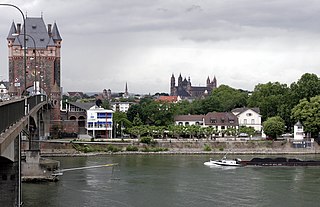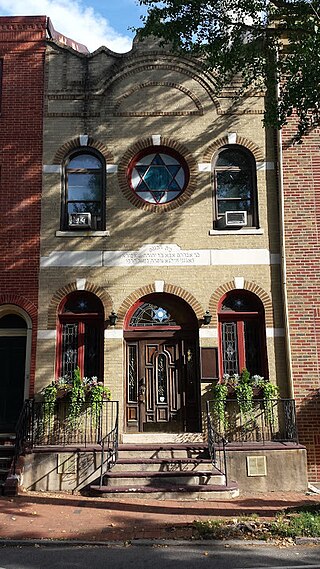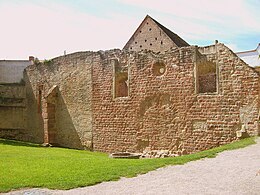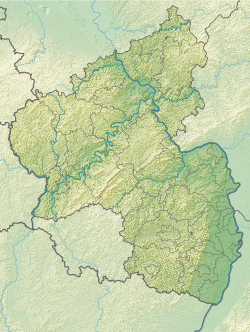
Mainz is the capital and largest city of the German state of Rhineland-Palatinate, and with around 221,000 inhabitants, it is Germany's 35th-largest city. It lies in the Rhine-Main Metropolitan Region—Germany's second-largest metropolitan region after Rhine-Ruhr—which also encompasses the cities of Frankfurt am Main, Wiesbaden, Darmstadt, Offenbach am Main, and Hanau.

Worms is a city in Rhineland-Palatinate, Germany, situated on the Upper Rhine about 60 km (40 mi) south-southwest of Frankfurt am Main. It had about 84,646 inhabitants as of 2022.

A synagogue, also called a shul or a temple, is a place of worship for Jews and Samaritans. It has a place for prayer where Jews attend religious services or special ceremonies such as weddings, b'nai mitzvah, choir performances, and children's plays. They also have rooms for study, social halls, administrative and charitable offices, classrooms for religious and Hebrew studies, and many places to sit and congregate. They often display commemorative, historic, or modern artwork alongside items of Jewish historical significance or history about the synagogue itself.

Speyer, historically known in English as Spires, is a city in Rhineland-Palatinate in Germany with approximately 50,000 inhabitants. Located on the left bank of the river Rhine, Speyer lies 25 km south of Ludwigshafen and Mannheim, and 21 km south-west of Heidelberg. Founded by the Romans, it is one of Germany's oldest cities. Speyer Cathedral, a number of other churches, and the Altpörtel dominate the Speyer landscape. In the cathedral, beneath the high altar, are the tombs of eight Holy Roman Emperors and German kings.

The Old New Synagogue, also called the Altneuschul, situated in Josefov, Prague, is Europe's oldest active synagogue. It is also the oldest surviving medieval synagogue of twin-nave design.

St Peter's Cathedral is a Roman Catholic church and former cathedral in Worms, southern Germany.

The B'nai Yosef Synagogue is an Orthodox Jewish synagogue located at 1616 Ocean Parkway and Avenue P in Brooklyn, New York City, New York, in the United States. The congregation practices in the Sephardi rite. The synagogue is considered "America's busiest synagogue for Middle and near-Eastern Jews", with over 30 prayer services daily.

The Ohel Yitzchak Synagogue also known as the Shomrei ha-Chomos Synagogue and the Ungarin Shul is located in the Muslim Quarter of the Old City of Jerusalem. It was built as a yeshiva in the 1870s by Kolel Shomrei HaChomos, an organization of Hungarian Jews, but was abandoned after the riots of 1938. Although the building was destroyed after 1948, it has recently been acquired by a Religious Zionist group for refurbishment and was reopened after restoration work finished in October 2008.

The Frankfurter Judengasse was the Jewish ghetto of Frankfurt and one of the earliest ghettos in Germany. It existed from 1462 until 1811 and was home to Germany's largest Jewish community in early modern times.

The Adams Street Shul, officially the Congregation Agudas Achim Anshei Sfard, is a Modern Orthodox Jewish synagogue located at 168 Adams Street in the village of Nonantum in Newton, Massachusetts, in the United States. Built in 1912 for a congregation established in 1911, it is home to Newton's oldest Jewish congregation, and one of the oldest in the region still occupying its original synagogue.

Beth Israel Synagogue is a historic former Jewish synagogue building at 238 Columbia Street in Cambridge, Middlesex County, Massachusetts, in the United States. Built in 1901, it was the first and principal synagogue to serve the East Cambridge area, and is a fine local example of Romanesque Revival architecture. Now converted into residential condominiums, it was listed on the National Register of Historic Places in 1982.

The Worms Synagogue, also known as Rashi Shul, is an 11th-century synagogue located in Worms, Germany. Situated in the northern part of the city center, the synagogue is one of the oldest in Germany. Because of its historical importance and its testimony to the European Jewish cultural tradition through millennia, the Worms Synagogue was inscribed on the UNESCO World Heritage List in 2021.

The Jewish Cemetery in Worms or Heiliger Sand, in Worms, Germany, is usually called the oldest surviving Jewish cemetery in Europe, although the Jewish burials in the Jewish sections of the Roman catacombs predate it by a millennium. The Jewish community of Worms was established by the early eleventh century, and the oldest tombstone still legible dates from 1058/59. The cemetery was closed in 1911, when a new cemetery was inaugurated. Some family burials continued until the late 1930s. The older part still contains about 1,300 tombstones, while the newer part contains more than 1,200. The cemetery is protected and cared for by the city of Worms, the Jewish community of Mainz-Worms, and the Landesdenkmalamt of Rhineland-Palatinate. The Salomon L. Steinheim-Institute for German-Jewish History at the University of Duisburg-Essen has been documenting and researching the site since 2005. Because of its cultural importance and preservation, the Jewish Cemetery was inscribed on the UNESCO World Heritage List in 2021.

The Alte Synagoge in Erfurt, Germany, is one of the best preserved medieval synagogues in Europe, its oldest parts dating back to the late 11th century. Most parts of the building date from around 1250–1320. Due to the fact that its roof is still standing, it is thought to be the oldest synagogue building intact in Europe and the world.

Ohave Shalom Synagogue, also referred to as the Woodridge Shul, is an Orthodox Jewish synagogue, that practices in the Ashkenazi rite, located at 14 Maurice Rose Street in Woodridge, in the Catskills region of southeast New York, in the United States. The brick building was erected in 1930 by a splinter group from what was then the village's only synagogue, later absorbed into Ohave Shalom itself.

The history of the Jews in Speyer reaches back over 1,000 years. In the Middle Ages, the city of Speyer, Germany, was home to one of the most significant Jewish communities in the Holy Roman Empire. Its significance is attested to by the frequency of the Ashkenazi Jewish surname Shapiro/Shapira and its variants Szpira/Spiro/Speyer. After many ups and downs throughout history, the community was totally wiped out in 1940 during the Holocaust. With the fall of the Iron Curtain in 1989 Jews again settled in Speyer and a first assembly took place in 1996.

The Synagoge Zürich Löwenstrasse is the oldest and largest synagogue in the Swiss municipality of Zürich. In 1884 built in Moorish style, the oldest synagogue of Zürich also houses the prayer and school house of Israelitische Cultusgemeinde Zürich (ICZ) which was founded in 1862. ICZ is a unified Jewish community having about 2,500 members, and thus the largest Jewish community in Switzerland, which since 2007 in the Canton of Zürich is recognized as a denomination, i.e. it has the same legal state as the Christian denominations. In the synagogue, the community celebrates the daily Minyan and Shabbat and holiday services. The synagogue is a cultural heritage of national importance in Switzerland.

The Vilna Congregation was a synagogue located in the Society Hill section of Center City, Philadelphia. The synagogue was home to an active congregation with Shabbat and holy day services, was affiliated with Lubavitch of Center City, and is now the location of an orthodox women's mikvah run by the Lubavitch Hasidic community. Menachem Schmidt was the rabbi of the synagogue, and continues to oversee the property and its operations.

The old Rottweil Synagogue is a synagogue in Rottweil in Baden-Württemberg. It was established in 1861. The desecrated Synagogue is located in Kameralamtsgasse 6, former Judengasse, close to Kapellenkirche and next to Bischöfliches Konvikt and gymnasium. The construction of a new synagogue in Rottweil began in March 2016.

The Synagogue du Quai Kléber was the main synagogue of Strasbourg, France before World War II. It was built in the "Neustadt" when the city was part of the German Empire and destroyed by Nazi Germany after it annexed the city in 1940; in the years between, Strasbourg and its Jewish community were French.


























